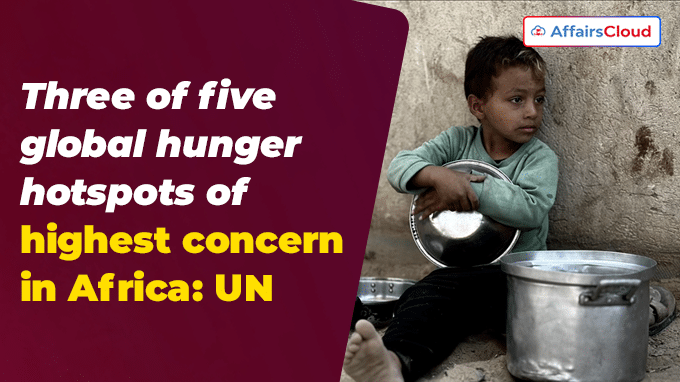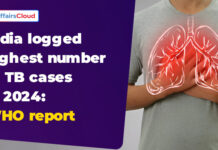 In June 2025, Rome (Italy) based Food and Agricultural Organization (FAO) of United Nations (UN) and World Food Programme (WFP) issued the ‘Hunger Hotspots: FAO-WFP early warning on acute food insecurity-June to October 2025 Outlook’ Report. The report warns that hunger is likely to get much worse in 13 countries and regions, which are among the world’s most serious hunger-affected areas in the coming months.
In June 2025, Rome (Italy) based Food and Agricultural Organization (FAO) of United Nations (UN) and World Food Programme (WFP) issued the ‘Hunger Hotspots: FAO-WFP early warning on acute food insecurity-June to October 2025 Outlook’ Report. The report warns that hunger is likely to get much worse in 13 countries and regions, which are among the world’s most serious hunger-affected areas in the coming months.
- The countries, Sudan, Palestine, South Sudan, Haiti and Mali remain at the highest concern level, necessitating the most urgent attention.
- The report identified conflict, economic shocks and climate-related hazards as the primary causes of starvation risks in the countries of the highest concern category.
- The analysis of current data in the report highlighted that people in the critical areas will encounter extreme food shortages and a heightened risk of hunger and mortality unless urgent humanitarian aid is provided.
About the Hunger Hotspots Outlook:
i.The Hunger Hotspots report, released twice a year, provides an early warning and forecast of worsening food crises expected over the next five months.
ii.The Hunger Hotspots: FAO-WEP early warning on acute food insecurity-June to October 2025 Outlook Report, identifies countries and regions where acute food insecurity is expected to deteriorate significantly.
iii.It aims to warn and mobilize the international community for urgent anticipatory action and targeted humanitarian response.
Highlights of the Report:
i.Yemen, the Democratic Republic of Congo, Myanmar, and Nigeria are classified as hotspots of very high concern and require urgent attention to save lives and livelihoods and for preventing further deterioration.
- Other hotspots are Burkina Faso, Chad, Somalia, and the Syrian Arab Republic.
ii.The report emphasizes, Armed violence remains the primary driver of acute food insecurity in 12 of the 13 hotspots. In all the hotspots of highest concern, widespread and escalating armed violence is a major driver of the deterioration in food security.
iii.In Sudan, famine was declared in 2024, and the situation is expected to continue because of conflict and ongoing displacement. Approximately 24.6 million individuals were expected to experience crisis or worse (Integrated Food Security Phase Classification (IPC) Phase 3 or higher) levels of severe food insecurity, with 637,000 people facing Catastrophe (IPC Phase 5) until May 2025.
- In South Sudan, subnational violence and political tensions are compounding macro-economic challenges and flood risks.
- Haiti remains a hotspot of highest concern for the third consecutive edition.
iv.The report identified, around 7.7 million individuals, accounting for 57% of South Sudan’s population, may experience severe food shortages (IPC Phase 3 or higher) from April to July 2025 due to flooding, political instability, and economic difficulties, with 63,000 facing conditions like famine.
iv.Global economic fragility, high debt burdens, geopolitical volatility and trade disruptions continue to deepen food insecurity in several hunger hotspots.
- Several factors influence the inflation and the collapse of household purchasing power.In the Sudan, conflict drives the risk of partial economic collapse in 2025, with high inflation severely limiting food access.
v.As per the report, around 2,600 individuals in Mali could face starvation between June and August 2025 due to ongoing conflict and elevated grain prices, unless timely aid is delivered.
vi.In Palestine, Israel’s ongoing military actions and the blockade of Gaza have resulted in severe food shortages for the entire population of 2.1 million, with nearly 500,000 people at risk of famine by the end of September 2025.
vii.Ethiopia, Kenya, Lebanon, Lesotho, Malawi, Mozambique, Namibia, Niger, Zambia, and Zimbabwe were removed from the Hunger Hotspots list.
Recent Related News:
In May 2025, Rome (Italy)-based United Nations (UN)’s Food and Agriculture Organisation (FAO) released its latest report titled ‘2025 Global Report on Food Crisis (GRFC)’. The report revealed that nearly 300 million (295.3 million) people across 53 countries and territories faced acute levels of hunger in 2024, marking an increase of 13.7 million compared to 2023.




